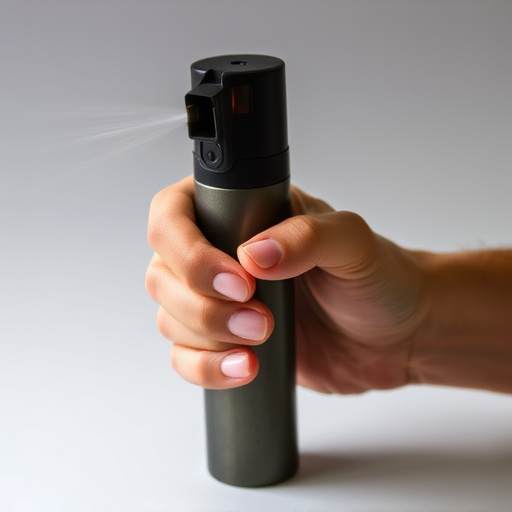In low light environments, pepper spray becomes a critical self-defense tool. Effective deployment requires targeting sensitive areas like eyes, nose, and mouth, with training essential for accurate aim in dim conditions. Success hinges on timing, proximity, and awareness, leveraging darkness to gain an edge while navigating unique challenges. Specialized tactics include using flashlights, reflective objects, and practicing in simulated low light scenarios. Regular training and maintenance ensure optimal performance when self-defense is crucial. Key safety considerations involve storage, handling, disposal, understanding spray effects, de-escalation, and maintaining safe distances.
“Uncover the ultimate self-defense tool—maximum strength pepper spray—in low light conditions. This article demystifies ‘low light pepper spray tactics’, offering insights into its effectiveness during night time or dimly lit scenarios. From understanding the basics of this potent defense mechanism to mastering tactics in dark environments, we explore training and safety considerations for optimal use. Learn how to harness its power, ensuring both protection and compliance with legal guidelines.”
- Understanding Maximum Strength Pepper Spray: The Basics
- Low Light Conditions: Challenges and Opportunities
- Effective Tactics for Defense in Dark Environments
- Training and Safety Considerations for Optimal Pepper Spray Use
Understanding Maximum Strength Pepper Spray: The Basics
Maximum strength pepper spray is a powerful self-defense tool designed to incapacitate an attacker temporarily, giving users an essential window of opportunity in low light or dark environments. This type of spray delivers a high concentration of capsaicin, the active ingredient responsible for the burning sensation and temporary blindness it causes. Unlike regular pepper spray, which may be effective at a distance, maximum strength varieties often offer enhanced close-range protection.
Understanding how to deploy this potent defense correctly is crucial. In low light pepper spray tactics, timing and proximity are key. Users should aim for the eyes, nose, and mouth, as these areas are most sensitive to capsaicin. Training and practice can help individuals master the technique, ensuring they can employ it effectively when every second counts.
Low Light Conditions: Challenges and Opportunities
In low light conditions, pepper spray tactics take on a new dimension. Nighttime altercations or enclosed spaces can amplify the challenges faced by individuals aiming to defend themselves with pepper spray. Lack of visibility may hinder target acquisition and make it harder to assess distance, which is crucial for effective deployment. However, these conditions also present opportunities. Reduced lighting allows for stealthier approach and surprise factor, giving the defender an edge in disorienting their opponent before they can react fully. Low light pepper spray tactics require practitioners to be highly attuned to their surroundings, employing strategies that leverage darkness to their advantage while navigating the unique challenges it poses.
Effective Tactics for Defense in Dark Environments
In low light or dark environments, pepper spray defense takes on a different dimension. The effectiveness of your spray can be significantly impacted by reduced visibility. Here, specialized low light pepper spray tactics become essential. Look for spray devices with built-in flashlights to momentarily blind aggressors and provide you crucial seconds to escape or de-escalate the situation. Aim for the face – eyes, nose, and mouth – as these are sensitive areas even in dim conditions. Practice your aim during training sessions under simulated low light scenarios to improve precision.
Additionally, reflect lights strategically using reflective objects on your person, like a high-vis bandana or belt loop, to disrupt the aggressor’s vision further. Remember, in these situations, every flicker of light can offer an advantage. Keep your spray ready at hand, ensuring it’s easily accessible without compromising balance or visibility. Regularly test and maintain your equipment to ensure optimal performance when it matters most.
Training and Safety Considerations for Optimal Pepper Spray Use
When it comes to training for pepper spray defense, understanding low light tactics is paramount. In scenarios where visibility is limited—due to darkness, smoke, or other obstructions—individuals must be adept at deploying pepper spray effectively. This involves practicing aim and range in dimly lit environments, learning to compensate for reduced sight, and developing strategies for quick, accurate applications. Regular training sessions focused on low light pepper spray tactics can significantly enhance an individual’s ability to defend themselves in challenging conditions.
Safety considerations cannot be overlooked when handling and using pepper spray. Users must receive comprehensive instruction on proper storage, handling, and disposal procedures to prevent accidental discharge or contamination. Additionally, understanding the spray’s effects—including its range, duration, and potential for cross-contamination—is crucial. Training should also cover de-escalation techniques and safe distances to maintain, ensuring that individuals use pepper spray as a last resort while mitigating risks to themselves and others.
In conclusion, understanding maximum strength pepper spray and its unique advantages in low light conditions is paramount for effective personal defense. By mastering specific tactics tailored for dark environments, individuals can maximize their safety during potentially dangerous encounters. Regular training and strict adherence to safety protocols are essential to ensure responsible and optimal use of this powerful tool. Equip yourself with the knowledge of low light pepper spray tactics to gain a crucial edge in unforeseen situations.
